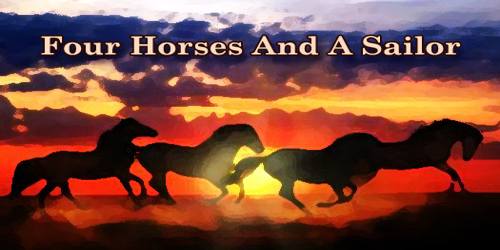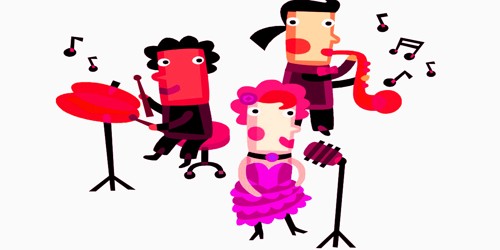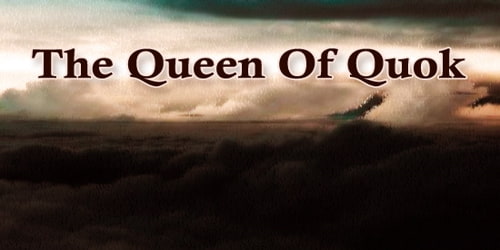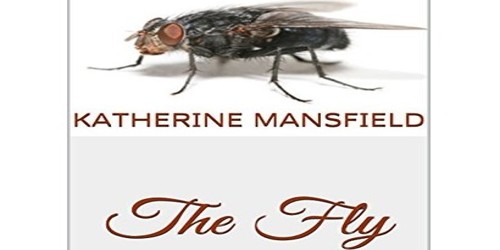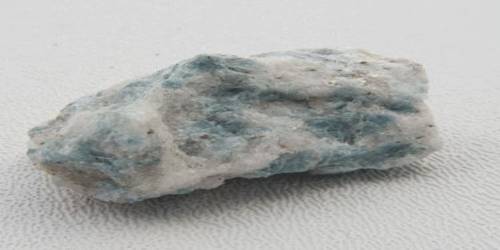“Huh! Drive four horses! I wouldn’t sit behind you not for a thousand dollars–over them mountain roads.”
So said Henry, and he ought to have known, for he drives four horses himself.
Said another Glen Ellen friend: “What? London? He drive four horses? Can’t drive one!”
And the best of it is that he was right. Even after managing to get a few hundred miles with my four horses, I don’t know how to drive one. Just the other day, swinging down a steep mountain road and rounding an abrupt turn, I came full tilt on a horse and buggy being driven by a woman up the hill. We could not pass on the narrow road, where was only a foot to spare, and my horses did not know how to back, especially uphill. About two hundred yards down the hill was a spot where we could pass. The driver of the buggy said she didn’t dare back down because she was not sure of the brake. And as I didn’t know how to tackle one horse, I didn’t try it. So we unhitched her horse and backed down by hand. Which was very well, till it came to hitching the horse to the buggy again. She didn’t know how. I didn’t either, and I had depended on her knowledge. It took us about half an hour, with frequent debates and consultations, though it is an absolute certainty that never in its life was that horse hitched in that particular way.
No; I can’t harness up one horse. But I can four, which compels me to back up again to get to my beginning. Having selected Sonoma Valley for our abiding place, Charmian and I decided it was about time we knew what we had in our own county and the neighboring ones. How to do it, was the first question. Among our many weaknesses is the one of being old- fashioned. We don’t mix with gasolene very well. And, as true sailors should, we naturally gravitate toward horses. Being one of those lucky individuals who carries his office under his hat, I should have to take a typewriter and a load of books along. This put saddle-horses out of the running. Charmian suggested driving a span. She had faith in me; besides, she could drive a span herself. But when I thought of the many mountains to cross, and of crossing them for three months with a poor tired span, I vetoed the proposition and said we’d have to come back to gasolene after all. This she vetoed just as emphatically, and a deadlock obtained until I received inspiration.
“Why not drive four horses?” I said.
“But you don’t know how to drive four horses,” was her objection.
I threw my chest out and my shoulders back. “What man has done, I can do,” I proclaimed grandly. “And please don’t forget that when we sailed on the Snark I knew nothing of navigation, and that I taught myself as I sailed.”
“Very well,” she said. (And there’s faith for you!) “They shall be four saddle horses, and we’ll strap our saddles on behind the rig.”
It was my turn to object. “Our saddle horses are not broken to harness.”
“Then break them.”
And what I knew about horses, much less about breaking them, was just about as much as any sailor knows. Having been kicked, bucked off, fallen over backward upon, and thrown out and run over, on very numerous occasions, I had a mighty vigorous respect for horses; but a wife’s faith must be lived up to, and I went at it.
King was a polo pony from St. Louis, and Prince a many-gaited love-horse from Pasadena. The hardest thing was to get them to dig in and pull. They rollicked along on the levels and galloped down the hills, but when they struck an up-grade and felt the weight of the breaking-cart, they stopped and turned around and looked at me. But I passed them, and my troubles began. Milda was fourteen years old, an unadulterated broncho, and in temperament was a combination of mule and jack-rabbit blended equally. If you pressed your hand on her flank and told her to get over, she lay down on you. If you got her by the head and told her to back, she walked forward over you. And if you got behind her and shoved and told her to “Giddap!” she sat down on you. Also, she wouldn’t walk.
For endless weary miles I strove with her, but never could I get her to walk a step. Finally, she was a manger-glutton. No matter how near or far from the stable, when six o’clock came around she bolted for home and never missed the directest cross-road. Many times I rejected her.
The fourth and most rejected horse of all was the Outlaw. From the age of three to seven she had defied all horse-breakers and broken a number of them. Then a long, lanky cowboy, with a fifty-pound saddle and a Mexican bit had got her proud goat. I was the next owner. She was my favorite riding horse. Charmian said I’d have to put her in as a wheeler where I would have more control over her. Now Charmian had a favorite riding mare called Maid. I suggested Maid as a substitute. Charmian pointed out that my mare was a branded range horse, while hers was a near-thoroughbred, and that the legs of her mare would be ruined forever if she were driven for three months. I acknowledged her mare’s thoroughbredness, and at the same time defied her to find any thoroughbred with as small and delicately-viciously pointed ears as my Outlaw. She indicated Maid’s exquisitely thin shinbone. I measured the Outlaw’s. It was equally thin, although, I insinuated, possibly more durable. This stabbed Charmian’s pride. Of course her near-thoroughbred Maid, carrying the blood of “old” Lexington, Morella, and a streak of the super-enduring Morgan, could run, walk, and work my unregistered Outlaw into the ground; and that was the very precise reason why such a paragon of a saddle animal should not be degraded by harness.
So it was that Charmian remained obdurate, until, one day, I got her behind the Outlaw for a forty-mile drive. For every inch of those forty miles the Outlaw kicked and jumped, in between the kicks and jumps finding time and space in which to seize its team-mate by the back of the neck and attempt to drag it to the ground. Another trick the Outlaw developed during that drive was suddenly to turn at right angles in the traces and endeavour to butt its team-mate over the grade. Reluctantly and nobly did Charmian give in and consent to the use of Maid. The Outlaw’s shoes were pulled off, and she was turned out on range.
Finally, the four horses were hooked to the rig a light Studebaker trap. With two hours and a half of practice, in which the excitement was not abated by several jack-poles and numerous kicking matches, I announced myself as ready for the start. Came the morning, and Prince, who was to have been a wheeler with Maid, showed up with a badly kicked shoulder. He did not exactly show up; we had to find him, for he was unable to walk. His leg swelled and continually swelled during the several days we waited for him. Remained only the Outlaw. In from pasture she came, shoes were nailed on, and she was harnessed into the wheel. Friends and relatives strove to press accident policies on me, but Charmian climbed up alongside, and Nakata got into the rear seat with the typewriter Nakata, who sailed cabin-boy on the Snark for two years and who had shown himself afraid of nothing, not even of me and my amateur jamborees in experimenting with new modes of locomotion. And we did very nicely, thank you, especially after the first hour or so, during which time the Outlaw had kicked about fifty various times, chiefly to the damage of her own legs and the paintwork, and after she had bitten a couple of hundred times, to the damage of Maid’s neck and Charmian’s temper. It was hard enough to have her favourite mare in the harness without also enduring the spectacle of its being eaten alive.
Our leaders were joys. King being a polo pony and Milda a rabbit, they rounded curves beautifully and darted ahead like coyotes out of the way of the wheelers. Milda’s besetting weakness was a frantic desire not to have the lead-bar strike her hocks. When this happened, one of three things occurred: either she sat down on the lead-bar, kicked it up in the air until she got her back under it, or exploded in a straight-ahead, harness-disrupting jump. Not until she carried the lead-bar clean away and danced a break-down on it and the traces, did she behave decently. Nakata and I made the repairs with good old-fashioned bale-rope, which is stronger than wrought-iron any time, and we went on our way.
In the meantime I was learning I shall not say to tool a four-in-hand but just simply to drive four horses. Now it is all right enough to begin with four work-horses pulling a load of several tons. But to begin with four light horses, all running, and a light rig that seems to outrun them well, when things happen they happen quickly. My weakness was total ignorance. In particular, my fingers lacked training, and I made the mistake of depending on my eyes to handle the reins. This brought me up against a disastrous optical illusion. The bight of the off head-line, being longer and heavier than that of the off wheel-line, hung lower.
In a moment requiring quick action, I invariably mistook the two lines. Pulling on what I thought was the wheel-line, in order to straighten the team; I would see the leaders swing abruptly around into a jack-pole. Now for sensations of sheer impotence, nothing can compare with a jack-pole, when the horrified driver beholds his leaders prancing gaily up the road and his wheelers jogging steadily down the road, all at the same time and all harnessed together and to the same rig.
I no longer jack-pole and I don’t mind admitting how I got out of the habit. It was my eyes that enslaved my fingers into ill practices. So I shut my eyes and let the fingers go it alone. To-day my fingers are independent of my eyes and work automatically. I do not see what my fingers do. They just do it. All I see is the satisfactory result.
Still we managed to get over the ground that first day down sunny Sonoma Valley to the old town of Sonoma, founded by General Vallejo as the remotest outpost on the northern frontier for the purpose of holding back the Gentiles, as the wild Indians of those days were called. Here history was made. Here the last Spanish mission was reared; here the Bear flag was raised, and here Kit Carson, and Fremont, and all our early adventurers came and rested in the days before the days of gold.
We swung on over the low, rolling hills, through miles of dairy farms and chicken ranches where every blessed hen is white, and down the slopes to Petaluma Valley. Here, in 1776, Captain Quiros came up Petaluma Creek from San Pablo Bay in quest of an outlet to Bodega Bay on the coast. And here, later, the Russians, with Alaskan hunters, carried skin boats across from Fort Ross to poach for sea-otters on the Spanish preserve of San Francisco Bay. Here, too, still, later, General Vallejo built a fort, which still stands one of the finest examples of Spanish adobe that remain to us. And here, at the old fort, to bring the chronicle up to date, our horses proceeded to make peculiarly personal history with astonishing success and dispatch. King, our peerless, polo-pony leader, went lame. So hopelessly lame did he go that no expert, then and afterward, could determine whether the lameness was in his frogs, hoofs, legs, shoulders, or head. Maid picked up a nail and began to limp. Milda, figuring the day already sufficiently spent and maniacal with manger-gluttony, began to rabbit-jump. All that held her was the bale rope. And the Outlaw, game to the last, exceeded all previous exhibitions of skin-removing, paint-marring, and horse-eating.
At Petaluma we rested over while King was returned to the ranch and Prince sent to us. Now Prince had proved himself an excellent wheeler, yet he had to go into the lead and let the Outlaw retain his old place. There is an axiom that a good wheeler is a poor leader. I object to the last adjective. A good wheeler makes an infinitely worse kind of a leader than that. I know . . . now. I ought to know. Since that day I have driven Prince a few hundred miles in the lead. He is neither any better nor any worse than the first mile he ran in the lead, and his worst is even extremely worse than what you are thinking. Not that he is vicious. He is merely a good-natured rogue who shakes hands for sugar, steps on your toes out of sheer excessive friendliness, and just goes on loving you in your harshest moments.
But he won’t get out of the way. Also, whenever he is reproved for being in the wrong, he accuses Milda of it and bites the back of her neck. So bad has this become that whenever I yell “Prince!” in a loud voice, Milda immediately rabbit-jumps to the side, straight ahead, or sits down on the lead-bar. All of which is quite disconcerting. Picture it yourself. You are swinging round a sharp, down-grade, mountain curve, at a fast trot. The rock wall is the outside of the curve. The inside of the curve is a precipice. The continuance of the curve is a narrow, unrailed bridge. You hit the curve; throwing the leaders in against the wall and making the polo-horse do the work. All is lovely. The leaders are hugging the wall like nestling doves. But the moment comes in the evolution when the leaders must shoot out ahead. They really must shoot, or else they’ll hit the wall and miss the bridge. Also, behind them are the wheelers, and the rig, and you have just eased the brake in order to put sufficient snap into the manoeuvre. If ever team-work is required, now is the time. Milda tries to shoot. She does her best, but Prince, bubbling over with roguishness, lags behind. He knows the trick. Milda is half a length ahead of him. He times it to the fraction of a second. Maid, in the wheel, over-running him, naturally bites him. This disturbs the Outlaw, who has been behaving beautifully, and she immediately reaches across for Maid. Simultaneously, with a fine display of firm conviction that it’s all Milda’s fault, Prince sinks his teeth into the back of Milda’s defenceless neck. The whole thing has occurred in less than a second. Under the surprise and pain of the bite, Milda either jumps ahead to the imminent peril of harness and lead-bar, or smashes into the wall, stops short with the lead-bar over her back, and emits a couple of hysterical kicks. The Outlaw invariably selects this moment to remove paint. And after things are untangled and you have had time to appreciate the close shave, you go up to Prince and reprove him with your choicest vocabulary. And Prince, gazelle-eyed and tender, offers to shake hands with you for sugar. I leave it to anyone: a boat would never act that way.
We have some history north of the Bay. Nearly three centuries and a half ago, that doughty pirate and explorer, Sir Francis Drake, combing the Pacific for Spanish galleons, anchored in the bight formed by Point Reyes, on which to-day is one of the richest dairy regions in the world. Here, less than two decades after Drake, Sebastien Carmenon piled up on the rocks with a silk-laden galleon from the Philippines. And in this same bay of Drake, long afterward, the Russian fur-poachers rendezvous’d their bidarkas and stole in through the Golden Gate to the forbidden waters of San Francisco Bay.
Farther up the coast, in Sonoma County, we pilgrimaged to the sites of the Russian settlements. At Bodega Bay, south of what today is called Russian River, was their anchorage, while north of the river they built their fort. And much of Fort Ross still stands. Log-bastions, church, and stables hold their own, and so well, with rusty hinges creaking, that we warmed ourselves at the hundred-years-old double fireplace and slept under the hand-hewn roof beams still held together by spikes of hand-wrought iron.
We went to see where history had been made, and we saw scenery as well. One of our stretches in a day’s drive was from beautiful Inverness on Tomales Bay, down the Olema Valley to Bolinas Bay, along the eastern shore of that body of water to Willow Camp, and up over the sea-bluffs, around the bastions of Tamalpais, and down to Sausalito. From the head of Bolinas Bay to Willow Camp the drive on the edge of the beach, and actually, for half-mile stretches, in the waters of the bay itself, was a delightful experience. The wonderful part was to come. Very few San Franciscans, much less Californians, know of that drive from Willow Camp, to the south and east, along the poppy-blown cliffs, with the sea thundering in the sheer depths hundreds of feet below and the Golden Gate opening up ahead, disclosing smoky San Francisco on her many hills. Far off, blurred on the breast of the sea, can be seen the Farallones, which Sir Francis Drake passed on a S. W. course in the thick of what he describes as a “stynking fog.” Well might he call it that, and a few other names, for it was the fog that robbed him of the glory of discovering San Francisco Bay.
It was on this part of the drive that I decided at last I was learning real mountain-driving. To confess the truth, for delicious titillation of one’s nerve, I have since driven over no mountain road that was worse, or better, rather, than that piece.
And then the contrast! From Sausalito, over excellent, park-like boulevards, through the splendid redwoods and homes of Mill Valley, across the blossomed hills of Marin County, along the knoll-studded picturesque marshes, past San Rafael resting warmly among her hills, over the divide and up the Petaluma Valley, and on to the grassy feet of Sonoma Mountain and home. We covered fifty-five miles that day. Not so bad, eh, for Prince the Rogue, the paint-removing Outlaw, the thin-shanked thoroughbred, and the rabbit-jumper? And they came in cool and dry, ready for their mangers and the straw.
Oh, we didn’t stop. We considered we were just starting, and that was many weeks ago. We have kept on going over six counties which are comfortably large, even for California, and we are still going. We have twisted and tabled, criss-crossed our tracks, made fascinating and lengthy dives into the interior valleys in the hearts of Napa and Lake Counties, travelled the coast for hundreds of miles on end, and are now in Eureka, on Humboldt Bay, which was discovered by accident by the gold seekers, who were trying to find their way to and from the Trinity diggings. Even here, the white man’s history preceded them, for dim tradition says that the Russians once anchored here and hunted sea-otter before the first Yankee trader rounded the Horn, or the first Rocky Mountain trapper thirsted across the “Great American Desert” and trickled down the snowy Sierras to the sun-kissed land. No; we are not resting our horses here on Humboldt Bay. We are writing this article, gorging on abalones and mussels, digging clams, and catching record-breaking sea- trout and rock-cod in the intervals in which we are not sailing, motor- boating, and swimming in the most temperately equable climate we have ever experienced.
These comfortably large counties! They are veritable empires. Take Humboldt, for instance. It is three times as large as Rhode Island, one and a half times as large as Delaware, almost as large as Connecticut, and half as large as Massachusetts. The pioneer has done his work in this north of the bay region, the foundations are laid, and all is ready for the inevitable inrush of population and adequate development of resources which so far have been no more than skimmed, and casually and carelessly skimmed at that. This region of the six counties alone will someday support a population of millions. In the meanwhile, O you home- seekers, you wealth-seekers, and, above all, you climate-seekers now is the time to get in on the ground floor.
Robert Ingersoll once said that the genial climate of California would in a fairly brief time evolve a race resembling the Mexicans, and that in two or three generations the Californians would be seen of a Sunday morning on their way to a cockfight with a rooster under each arm. Never was made a rasher generalization, based on so absolute an ignorance of facts. It is to laugh. Here is a climate that breeds vigour, with just sufficient geniality to prevent the expenditure of most of that vigour in fighting the elements. Here is a climate where a man can work three hundred and sixty-five days in the year without the slightest hint of enervation, and where for three hundred and sixty-five nights he must perforce sleep under blankets. What more can one say? I consider myself somewhat of climate expert, having adventured among most of the climates of five out of the six zones. I have not yet been in the Antarctic, but whatever climate obtains there will not deter me from drawing the conclusion that nowhere is there a climate to compare with that of this region. Maybe I am as wrong as Ingersoll was. Nevertheless I take my medicine by continuing to live in this climate. Also, it is the only medicine I ever take.
But to return to the horses. There is some improvement. Milda has actually learned to walk. Maid has proved her thoroughbredness by never tiring on the longest days, and, while being the strongest and highest spirited of all, by never causing any trouble save for an occasional kick at the Outlaw. And the Outlaw rarely gallops, no longer butts, only periodically kicks, comes in to the pole and does her work without attempting to vivisect Maid’s medulla oblongata, and marvel of marvels is really and truly getting lazy. But Prince remains the same incorrigible, loving and lovable rogue he has always been.
And the country we’ve been over! The drives through Napa and Lake Counties! One, from Sonoma Valley, via Santa Rosa, we could not refrain from taking several ways, and on all the ways we found the roads excellent for machines as well as horses. One route, and a more delightful one for an automobile cannot be found, is out from Santa Rosa, past old Altruria and Mark West Springs, then to the right and across to Calistoga in Napa Valley. By keeping to the left, the drive holds on up the Russian River Valley, through the miles of the noted Asti Vineyards to Cloverdale, and then by way of Pieta, Witter, and Highland Springs to Lakeport. Still another way we took was down Sonoma Valley, skirting San Pablo Bay, and up the lovely Napa Valley. From Napa were side excursions through Pope and Berryessa Valleys, on to Aetna Springs, and still on, into Lake County, crossing the famous Langtry Ranch.
Continuing up the Napa Valley, walled on either hand by great rock palisades and redwood forests and carpeted with endless vineyards, and crossing the many stone bridges for which the County is noted and which are a joy to the beauty-loving eyes as well as to the four-horse tyro driver, past Calistoga with its old mud-baths and chicken-soup springs, with St. Helena and its giant saddle ever towering before us, we climbed the mountains on a good grade and dropped down past the quicksilver mines to the canyon of the Geysers. After a stopover night and an exploration of the miniature-grand volcanic scene, we pulled on across the canyon and took the grade where the cicadas simmered audibly in the noon sunshine among the hillside manzanitas. Then, higher, came the big cattle-dotted upland pastures, and the rocky summit. And here on the summit, abruptly, we caught a vision, or what seemed a mirage. The ocean we had left long days before, yet far down and away shimmered a blue sea, framed on the farther shore by rugged mountains, on the nearshore by fat and rolling farmlands. Clear Lake was before us, and like proper sailors we returned to our sea, going for a sail, a fish, and a swim ere the day was done and turning into tired Lakeport blankets in the early evening. Well has Lake County been called the Walled-in County. But the railroad is coming. They say the approach we made to Clear Lake is similar to the approach to Lake Lucerne. Be that as it may, the scenery, with its distant snow-capped peaks, can well be called Alpine.
And what can be more exquisite than the drive out from Clear Lake to Ukiah by way of the Blue Lakes chain! Every turn bringing into view a picture of breathless beauty; every glance backward revealing some perfect composition in line and color, the intense blue of the water margined with splendid oaks, green fields, and swaths of orange poppies. But those side glances and backward glances were provocative of trouble. Charmian and I disagreed as to which way the connecting stream of water ran. We still disagree, for at the hotel, where we submitted the affair to arbitration, the hotel manager and the clerk likewise disagreed. I assume, now, that we never will know which way that stream runs. Charmian suggests “both ways.” I refuse such a compromise. No stream of water I ever saw could accomplish that feat at one and the same time. The greatest concession I can make is that sometimes it may run one way and sometimes the other and that in the meantime we should both consult an oculist.
More valley from Ukiah to Willits, and then we turned westward through the virgin Sherwood Forest of magnificent redwood, stopping at Alpine for the night and continuing on through Mendocino County to Fort Bragg and “salt water.” We also came to Fort Bragg up the coast from Fort Ross, keeping our coast journey intact from the Golden Gate. The coast weather was cool and delightful, the coast driving superb. Especially in the Fort Ross section did we find the roads thrilling, while all the way along we followed the sea.
At every stream, the road skirted dizzy cliff-edges, dived down into lush growths of forest and ferns and climbed out along the cliff-edges again. The way was lined with flowers wild lilac, wild roses, poppies, and lupins. Such lupins! Giant clumps of them, of every lupin-shade and color. And it was along the Mendocino roads that Charmian caused many delays by insisting on getting out to pick the wild blackberries, strawberries, and thimble-berries which grew so profusely. And ever we caught peeps, far down, of steam schooners loading lumber in the rocky coves; ever we skirted the cliffs, day after day, crossing stretches of rolling farmlands and passing through thriving villages and saw-mill towns. Memorable was our launch-trip from Mendocino City up Big River, where the steering gears of the launches work the reverse of anywhere else in the world; where we saw a stream of logs, of six to twelve and fifteen feet in diameter, which filled the river bed for miles to the obliteration of any sign of water; and where we were told of a white or albino redwood tree. We did not see this last, so we cannot vouch for it.
All the streams were filled with trout, and more than once we saw the side-hill salmon on the slopes. No, side-hill salmon is not a peripatetic fish; it is a deer out of season. But the trout! At Gualala Charmian caught her first one. Once before in my life I had caught two . . . on angleworms. On occasion I had tried fly and spinner and never got a strike, and I had come to believe that all this talk of fly-fishing was just so much nature-faking. But on the Gualala River I caught trout a lot of them on fly and spinners; and I was beginning to feel quite an expert, until Nakata, fishing on bottom with a pellet of bread for bait, caught the biggest trout of all. I now affirm there is nothing in science nor in art. Nevertheless, since that day poles and baskets have been added to our baggage, we tackle every stream we come to, and we no longer are able to remember the grand total of our catch.
At Usal, many hilly and picturesque miles north of Fort Bragg, we turned again into the interior of Mendocino, crossing the ranges and coming out in Humboldt County on the south fork of Eel River at Garberville. Throughout the trip, from Marin County north, we had been warned of “bad roads ahead.” Yet we never found those bad roads. We seemed always to be just ahead of them or behind them. The farther we came the better the roads seemed, though this was probably due to the fact that we were learning more and more what four horses and a light rig could do on a road. And thus do I save my face with all the counties. I refuse to make invidious road comparisons. I can add that while, save in rare instances on steep pitches, I have trotted my horses down all the grades, I have never had one horse fall down nor have I had to send the rig to a blacksmith shop for repairs.
Also, I am learning to throw leather. If any tyro thinks it is easy to take a short-handled, long-lashed whip, and throw the end of that lash just where he wants it, let him put on automobile goggles and try it. On reconsideration, I would suggest the substitution of a wire fencing-mask for the goggles. For days I looked at that whip. It fascinated me, and the fascination was composed mostly of fear. At my first attempt, Charmian and Nakata became afflicted with the same sort of fascination, and for a long time afterward, whenever they saw me reach for the whip, they closed their eyes and shielded their heads with their arms.
Here’s the problem. Instead of pulling honestly, Prince is lagging back and manoeuvring for a bite at Milda’s neck. I have four reins in my hands. I must put these four reins into my left hand, properly gather the whip handle and the bight of the lash in my right hand, and throw that lash past Maid without striking her and into Prince. If the lash strikes Maid, her thoroughbredness will go up in the air, and I’ll have a case of horse hysteria on my hands for the next half hour. But follow. The whole problem is not yet stated. Suppose that I miss Maid and reach the intended target. The instant the lash cracks, the four horses jump, Prince most of all, and his jump, with spread wicked teeth, is for the back of Milda’s neck. She jumps to escape which is her second jump, for the first one came when the lash exploded. The Outlaw reaches for Maid’s neck, and Maid, who has already jumped and tried to bolt, tries to bolt harder. And all this infinitesimal fraction of time I am trying to hold the four animals with my left hand, while my whip-lash, writhing through the air, is coming back to me. Three simultaneous things I must do: keep hold of the four reins with my left hand; slam on the brake with my foot, and on the rebound catch that flying lash in the hollow of my right arm and get the bight of it safely into my right hand. Then I must get two of the four lines back into my right hand and keep the horses from running away or going over the grade. Try it some time. You will find life anything but wearisome. Why the first time I hit the mark and made the lash go off like a revolver shot, I was so astounded and delighted that I was paralyzed. I forgot to do any of the multitudinous other things, tangled the whiplash in Maid’s harness, and was forced to call upon Charmian for assistance. And now, confession. I carry a few pebbles handy. They’re great for reaching Prince in a tight place. But just the same I’m learning that whip every day, and before I get home I hope to discard the pebbles. And as long as I rely on pebbles, I cannot truthfully speak of myself as “tooling a four-in-hand.”
From Garberville, where we ate eel to repletion and got acquainted with the aborigines, we drove down the Eel River Valley for two days through the most unthinkably glorious body of redwood timber to be seen anywhere in California. From Dyerville on to Eureka, we caught glimpses of railroad construction and of great concrete bridges in the course of building, which advertised that at least Humboldt County was going to be linked to the rest of the world.
We still consider our trip is just begun. As soon as this is mailed from Eureka, it’s heigh-ho! for the horses and pull on. We shall continue up the coast, turn in for Hoopa Reservation and the gold mines, and shoot down the Trinity and Klamath rivers in Indian canoes to Requa. After that, we shall go on through Del Norte County and into Oregon. The trip so far has justified us in taking the attitude that we won’t go home until the winter rains drive us in. And, finally, I am going to try the experiment of putting the Outlaw in the lead and relegating Prince to his old position in the near wheel. I won’t need any pebbles then.
Written by Jack London
